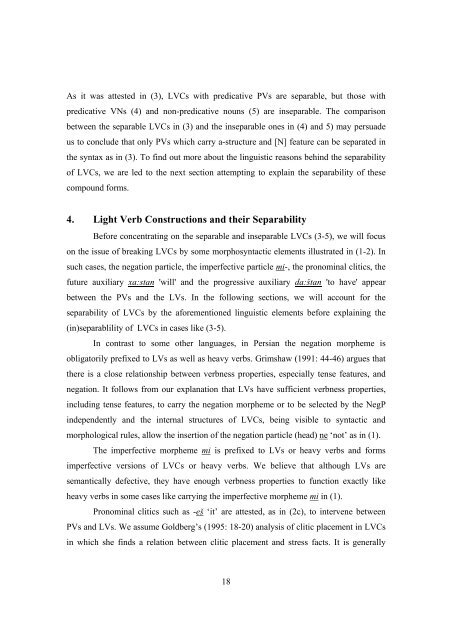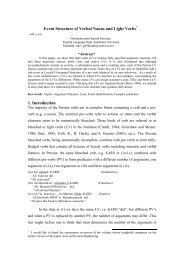Separability of Light Verb Constructions in Persian*
Separability of Light Verb Constructions in Persian*
Separability of Light Verb Constructions in Persian*
You also want an ePaper? Increase the reach of your titles
YUMPU automatically turns print PDFs into web optimized ePapers that Google loves.
As it was attested <strong>in</strong> (3), LVCs with predicative PVs are separable, but those with<br />
predicative VNs (4) and non-predicative nouns (5) are <strong>in</strong>separable. The comparison<br />
between the separable LVCs <strong>in</strong> (3) and the <strong>in</strong>separable ones <strong>in</strong> (4) and 5) may persuade<br />
us to conclude that only PVs which carry a-structure and [N] feature can be separated <strong>in</strong><br />
the syntax as <strong>in</strong> (3). To f<strong>in</strong>d out more about the l<strong>in</strong>guistic reasons beh<strong>in</strong>d the separability<br />
<strong>of</strong> LVCs, we are led to the next section attempt<strong>in</strong>g to expla<strong>in</strong> the separability <strong>of</strong> these<br />
compound forms.<br />
4. <strong>Light</strong> <strong>Verb</strong> <strong>Constructions</strong> and their <strong>Separability</strong><br />
Before concentrat<strong>in</strong>g on the separable and <strong>in</strong>separable LVCs (3-5), we will focus<br />
on the issue <strong>of</strong> break<strong>in</strong>g LVCs by some morphosyntactic elements illustrated <strong>in</strong> (1-2). In<br />
such cases, the negation particle, the imperfective particle mi-, the pronom<strong>in</strong>al clitics, the<br />
future auxiliary xa:stan 'will' and the progressive auxiliary da:štan 'to have' appear<br />
between the PVs and the LVs. In the follow<strong>in</strong>g sections, we will account for the<br />
separability <strong>of</strong> LVCs by the aforementioned l<strong>in</strong>guistic elements before expla<strong>in</strong><strong>in</strong>g the<br />
(<strong>in</strong>)separablility <strong>of</strong> LVCs <strong>in</strong> cases like (3-5).<br />
In contrast to some other languages, <strong>in</strong> Persian the negation morpheme is<br />
obligatorily prefixed to LVs as well as heavy verbs. Grimshaw (1991: 44-46) argues that<br />
there is a close relationship between verbness properties, especially tense features, and<br />
negation. It follows from our explanation that LVs have sufficient verbness properties,<br />
<strong>in</strong>clud<strong>in</strong>g tense features, to carry the negation morpheme or to be selected by the NegP<br />
<strong>in</strong>dependently and the <strong>in</strong>ternal structures <strong>of</strong> LVCs, be<strong>in</strong>g visible to syntactic and<br />
morphological rules, allow the <strong>in</strong>sertion <strong>of</strong> the negation particle (head) ne ‘not’ as <strong>in</strong> (1).<br />
The imperfective morpheme mi is prefixed to LVs or heavy verbs and forms<br />
imperfective versions <strong>of</strong> LVCs or heavy verbs. We believe that although LVs are<br />
semantically defective, they have enough verbness properties to function exactly like<br />
heavy verbs <strong>in</strong> some cases like carry<strong>in</strong>g the imperfective morpheme mi <strong>in</strong> (1).<br />
Pronom<strong>in</strong>al clitics such as -eš ‘it’ are attested, as <strong>in</strong> (2c), to <strong>in</strong>tervene between<br />
PVs and LVs. We assume Goldberg’s (1995: 18-20) analysis <strong>of</strong> clitic placement <strong>in</strong> LVCs<br />
<strong>in</strong> which she f<strong>in</strong>ds a relation between clitic placement and stress facts. It is generally<br />
18



